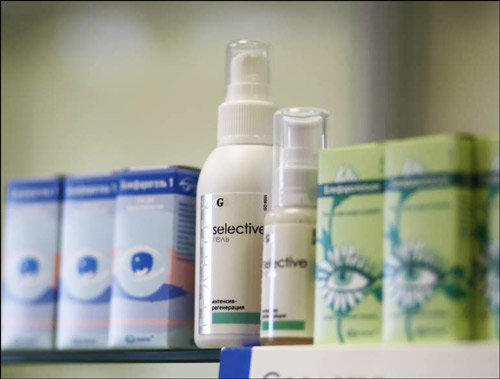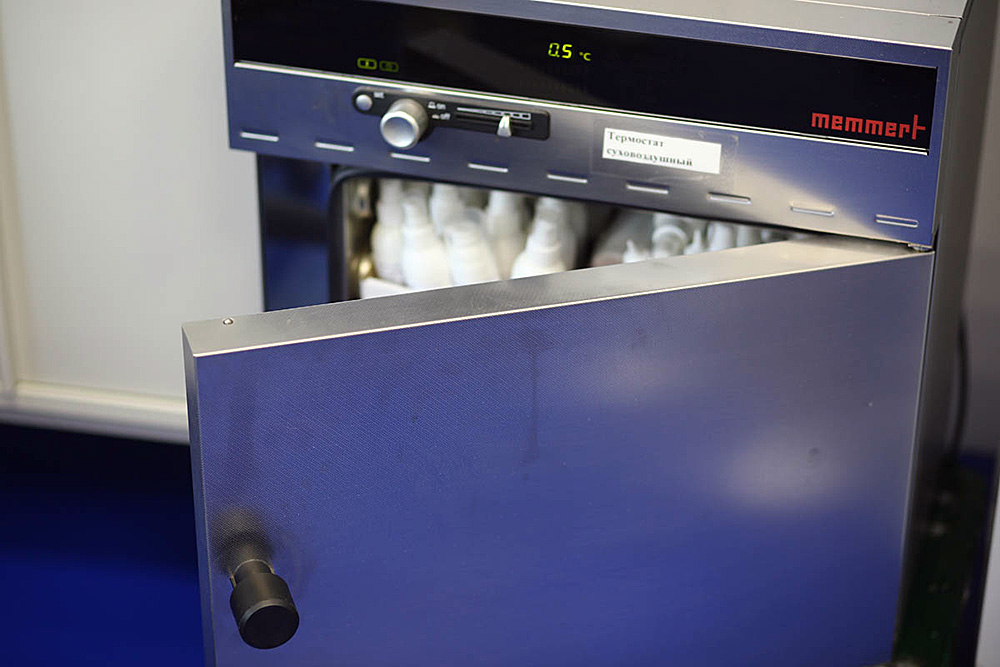How we developed a tool for intensive regeneration

Perhaps you know D-panthenol based products - these are sprays and ointments that are often used for burns. They have a common problem - there is more pain relief than, actually, regeneration. No, D-panthenol is a very good substance, it just needs more. And he also needs to penetrate deeper, you can try to combine it with other substances, and all this needs to be collected in a formula that does not create an almost tight film over the skin, which does not give heat to leave the burn injury (and direct the burn into the body).
Our developments in the transport of substances under the skin are among the best in the world, we have a very good laboratory for polymers, we produce 90 tons per month of ultrasound gel alone. Naturally, we look, what is the need, and what we can do perfectly. The need was discovered long ago - burns, insects, minor injuries, bedsores and diaper rash. Application - “applied-forgotten”, that is, regeneration in several applications.
With this tool turned out not to the end. The formula is great. But they didn’t hit the mass market for the price. I’ll tell you why, but you’ll have to start with the development features to make it clearer what the complexity is.
Formula Development
The development of formulas is as follows - first, the analogues are evaluated by the action (effectiveness of solving the main problem and possible side effects and limitations). If there are interesting options - their composition is investigated. We analyze the literature (reports and studies on this topic, other available sources), we look at analogues, and what they do not like the market for, we analyze the market for raw materials. Then we create an internal document - an application for development. Then in the laboratory they create several samples and we are already slowly looking at what works from this. That is, we select the input percentage of each substance, and this input percentage is selected by very complex multistage experiments - we know the approximate thresholds from the producers of raw materials (minimum efficiency and maximum safety). Next, the task to get into the ideal. And so with every ingredient. Sometimes lucky, and it turns out almost immediately, sometimes the balancing of the formula takes years.
If it is a special purpose medical gel - for example, electrical conductivity (for ECG), sound conduction (for ultrasound), and so on. In the case of regenerative means - it was necessary to be more effective than those that have historically been taken into space in first-aid kits. That is, we have to heal burns in a matter of hours, remove scratches (but not develop a tool for open wounds, although we received permission for the wound surface), remove any rubbing and diaper rash.
The first thing we did was to compile a list of active substances that solve these problems. The second - solved the problem of D-panthenol with film and concentration. The concentration of D-panthenol in the final formula is much higher than that of sprays and ointments available in pharmacies at the time of publication. There is no film blocking heat dissipation. There is a protective film of the high molecular weight fraction of hyaluronic acid, which perfectly removes heat, but also perfectly moisturizes and protects the skin.
D-panthenol, by the way, has already received the "fifth breath" in medicine - new properties are being proved every year. But he is very "capricious" - it easily enters into any undesirable compounds. This is part of the problem with using it.
But this is not enough. We began to test the remaining possible active substances for a synergistic effect with these two. We already had a wonderful and very long experience with aloe vera on Blefarogel 1 - it has an excellent anti-inflammatory effect, combined with the effect of hyaluronic acid. They reinforce each other well and create a stable bundle. We also managed to add chitosan and beta-glucan, they gave a serious effect on stimulating natural regeneration processes. Chitosan is a building material of collagen and elastin, delivered locally (without the body synthesizing it itself - you just have to pick up these “depositories” and start building new structures, which is very simple and quick). Beta glucan is a polysaccharide slightly similar to hyaluronic acid. Its presence dramatically increases the activity of Langerhans cells, which leads to an increase in the process of cell renewal and an increase in the immune response. He, in fact, simulates an attack on the body, but without the attack itself. And the body responds.
Chamomile and calendula extracts were added almost without difficulty. In addition to supporting the main effect, they also relieve the itch, which is absolutely unimportant for medical purposes, but very important for patient comfort.
As a result, the active ingredients in terms of mass fraction turned out to be incredibly many by the standards of such means - usually we are talking about 1-2%, we are almost an order of magnitude more. Such things are very difficult (that is, long and, as a result, expensive) to stabilize by the formula in order to avoid mutual reactions over time. This formula was stabilized for almost two years - during the work, wheat germ and peptide components had to be removed - they could potentially strengthen the formula, but they entered into unnecessary reactions with time, which affected destabilization of the agent and reduced shelf life. And my task is 3 years, plus I need to set aside time for errors, microvibrations of mass fractions of formulas, forwarders-forwarders and pharmacy storekeepers for idiots. Mostly, of course, forwarders who carry our funds to the Far East.
Experimental testing of the shelf life of a product is determined as follows: the intermediate product is placed in an original package in a heating cabinet at a given temperature and kept for 120 days (this period is comparable to 2 years of storage of the product under normal conditions). Then, at the intermediate stages (30, 60, 90, 120 days), the initial and intermediate physicochemical parameters are compared. If significant differences in indicators are identified, testing is considered to be unrepresentative - in development it is equivalent to the need to upgrade the formula.

Interestingly there were tests. Such things are forbidden for animals to test or forbidden (since we are still certified for Europe, where thanks to zoo-defenders it is impossible to test anything that is planned to be recorded on animals), or extremely expensive (according to their protection protocols). 100 volunteer people are always much cheaper and more practical - people calmly agree to very many tests. The problem of people is that they are more complicated and diverse, plus the mice are clean and healthy, and the volunteers are all with their own stories of transferred or background processes. And this is in beta. At the alpha stage, developers test most often on themselves. Beta to check side effects, alpha - to check the main. We were “lucky” with the summer - mosquitoes, wasps, burns, scratches, a colleague caught a nail in the belly, the whole set. At the next stage, I agreed with colleagues from tattoo parlors and laser cosmetology - they, despite safety requirements in practice, often put their fingers under the laser, and burns occur regularly. Quite often for the primary sample, and doctors can clearly describe what happened according to different formulas. Measured the time of action formulas. Also, the memory is not pleasant. In the second part of the alpha, we distributed the tool to our employees who wanted it. They trust us in this regard, and they know that the risks there are only individual intolerance at this moment. Passed toxicology and microbiology (that is, the resistance of the formula to pathogenic organisms). Received a wide sample of reviews on different occasions, in particular, on frosty burns.
Toxicological tests and microbiology are carried out six weeks after the development and tests are ready, but we consider them to be uninformative, and we also make our deeper ones in beta. Then, in an abbreviated form, they are duplicated by an independent laboratory with state accreditation, but we have never failed them because of a fundamentally different development cycle. Preliminary thorough tests are cheaper in perspective.
At the beginning of the tests, one of our friends on vacation saved a girl-scuba diver and hit her foot in a coral hole (in Dahab on the Islands point). Who understands what it is about, he knows how scary it is. In short, natural regeneration is almost impossible. For several months in a row there will be a weeping ulcer (if you continue to dive, which our hero did several times), and then it will heal if you are lucky. Everyone said forget it. We are very slow, almost the entire development cycle, but pulled out. There was a real incentive to do the development. The scar, of course, remained, the leg looks relatively good, the functions of the site are partially lost, but this is not an ulcer, but relatively healthy tissue.
Nobody believed in such a result, we only hoped. When his foot began to regenerate, it was a holiday in the laboratory. The complete process was very long.
The speed of action is as follows: sunburn over the shoulders of a bright red and brownish hue (second degree) removes almost completely in 6 hours (no pain, no visually discernible, skin does not recede). Insects like mosquitoes - smear the bite site and forget that it was. The wasps were bitten - three masks, 4 hours before stabilization, 10-12 hours before the main symptoms disappeared. Scratches without access to blood - without number, quickly. Used for infant diaper rash and all sorts of rubbing, there is practice. We are very proud to have achieved this. We hope it will be taken at the next revision of the first-aid kit on the ISS because of its effectiveness.
We collected the formula, tested the substance, certified it in Russia and now we receive documents for Europe and other countries - but it does not have such commercial success as that of simple sprays on D-panthenol. But we will slowly develop, since the price on the shelf of a 30-gram package is about 700 rubles, and a 100-gram package is 1,400 rubles. Very expensive for domestic use non-coiled mark. The problem is a large proportion of active ingredients - they are all expensive.
Now we are considering the option of smaller packages in order to manage to meet the 300-400 rubles - perhaps we will use tubes of 5 or 10 milliliters, as for disposable toothpaste.
In Russia, it is available in professional cosmetics stores as a cosmetic. I do not urge to buy, the product is not massive, I repeat. It may become a bit cheaper when there are more lots. But if you get injured often or get microburns at least with the same ration, you may very, very much like it. There is simply nothing more powerful and effective for local regeneration.
All Articles